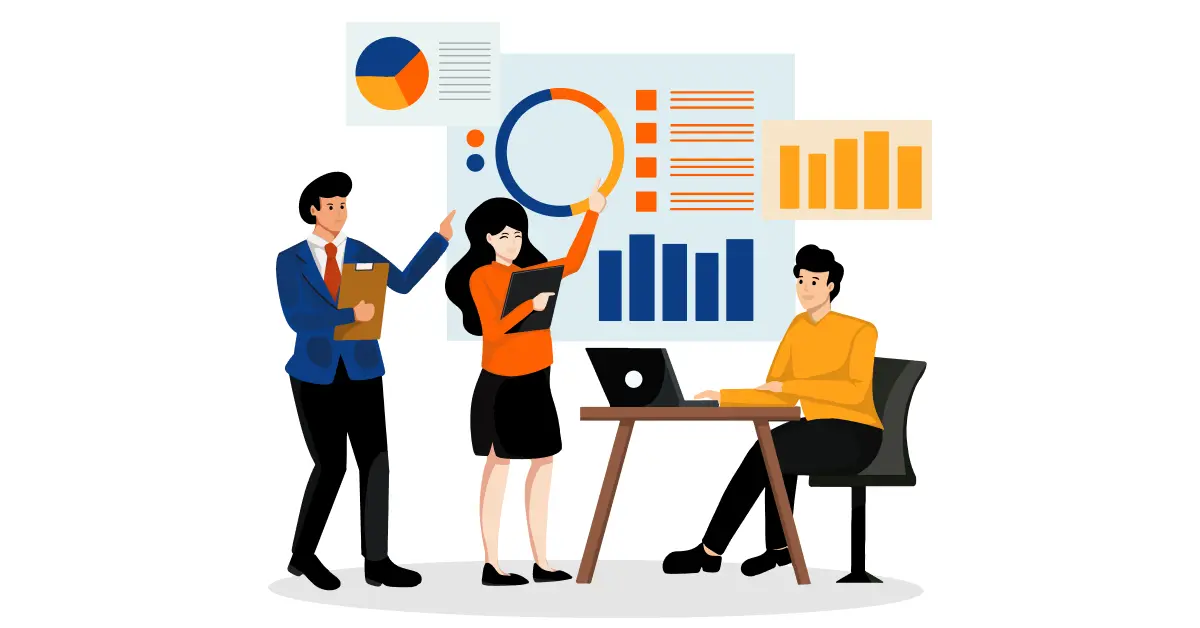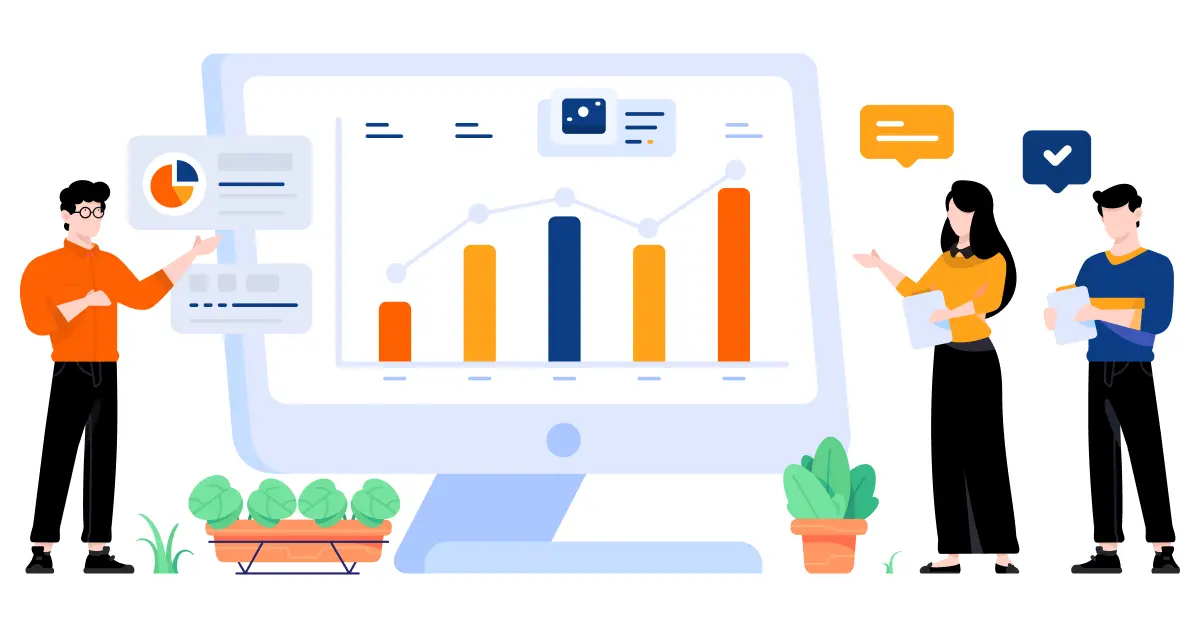
Meeting company goals in today’s lightning-fast business climate relies heavily on effective human resource management. Workforce analysis is helpful in this scenario. It is a meticulous procedure that involves examining and evaluating many aspects of the workforce to ensure that the right people with the right abilities are in the right place at the right time.
By using workforce analysis, businesses can make informed decisions that result in increased output, contented employees, and overall success. We will explore the meaning of workforce analysis, its importance, and the exact steps for conducting it with Leapmax, a workforce analytics platform, in this detailed guide.
Table of contents
- Understanding Workforce Analysis
- Steps to Conduct Workforce Analysis
- Leveraging Workforce Analysis for Managing Remote Employees
- Handling a Hybrid Workforce with Workforce Analysis
- Addressing Employee Burnout Through Workforce Analysis
- Promoting Employee Skill Development with Workforce Analysis
- Conclusion
Understanding Workforce Analysis
Understanding this concept involves comprehending its meaning and analyzing its importance in an organizational setup. Let’s explore it further.
What is Workforce Analysis?
Workforce analysis is the process of assessing and examining the current workforce to identify the abilities and skills that employees have in relation to the company’s goals and objectives. It involves collecting and analyzing data on a variety of workforce characteristics to identify skill gaps, project future labor needs, and create plans to close those gaps.
The ultimate goal of employee analysis is to match the company’s employees with its strategic goals, which will improve employee productivity and competitiveness overall.
Why is Workforce Analysis Important?
Workforce analysis is crucial for several reasons:
- It ensures that the workforce is in line with the organization’s strategic goals and objectives; therefore, it is important for strategic alignment.
- Workforce analysis helps to identify skill gaps and training needs and, therefore, assists in talent management.
- Improved employee performance is achieved by ensuring that the appropriate talents are available when needed.
- Workforce analysis enhances workforce deployment and planning to minimize labor expenditures and thus helps in increasing operational efficiency.
- It also helps improve employee satisfaction by meeting their needs for professional growth and lowering employee burnout.
Steps to Conduct Workforce Analysis
Conducting workforce analysis requires clarity of goals. This understanding is then backed by data that helps managers plan and make future decisions accordingly.
The following breakdown of steps will work in favor of making this process easy and practical:
Step 1: Define Objectives
The first and foremost thing to do is understand the objectives.
- Identifying goals is the first phase in workforce analysis.
- Knowing what you want to achieve with employee analytics will guide the entire procedure.
Goals could be identifying skills shortages, preparing for workforce changes, increasing employee skill development, or improving work productivity and efficiency.
Leapmax makes it easier to set particular targets, giving you up for focusing on your main areas of interest.
Step 2: Collect Data
An essential first step in workforce analysis is data collecting. It entails obtaining pertinent information on a range of workforce-related topics, such as:
- The Demographics: Gender, age, experience, education, etc.
- Proficiency and aptitudes: Present abilities, qualifications, education, etc.
- Performance metrics include things like attendance, employee productivity tracking, and work quality.
- Workforce Distribution: Department-wise distribution, role-specific distribution, etc.
Leapmax provides reliable data-gathering technologies that easily interface with current HR systems, guaranteeing thorough and precise data capture.
Step 3: Analyze Data
After gathering data, the next stage is to analyze it to learn more about the workforce.
- This includes finding skill gaps, which involves identifying gaps in skills and comparing their present skills with those needed, like time management.
- Once one skill gap has been identified, workforce forecasting begins, which requires projecting future labor requirements by analyzing trends and historical data.
- In the end, Analyzing workforce distribution is also important for identifying inequalities in how employees are distributed among jobs and departments.
With user-friendly dashboards and reports emphasizing important findings, Leapmax offers sophisticated employee analytics solutions that streamline data analysis.
Step 4: Develop Action Plans
Based on the analysis, develop action plans to address the identified issues. This may include:
- Training & Development Programs: Creating initiatives to close skill shortages and advance the professional growth of staff members.
- Strategies for Recruitment: Organizing hiring efforts to close skills gaps in the workforce.
- Personnel optimization refers to the application of techniques to enhance organizational productivity and optimize the distribution of personnel.
Leapmax offers insights and recommendations customized to your organization’s needs, making it possible to design strategies that are actually implemented. Time-tracking tools can help track employee performance.
Step 5: Implement Action Plans
Once action plans are developed, the next step is to implement them. This involves:
- Plans Communication: Outline the plans for each stakeholder in detail.
- Resource Allocation: Ensuring that the funds required for implementation are set aside.
- Monitoring Progress: Continually keeping an eye on an employee on how the implementation is going and adjusting as necessary.
Leapmax supports the implementation process by providing tools for project management, communication, and performance tracking.
Step 6: Monitor and Evaluate
The final step in workforce analysis is to monitor and evaluate the outcomes of the implemented action plans. This involves:
- Monitoring Key Metrics: Monitor key performance indicators closely to gauge how well the action plans work.
- Getting Input: To assess the success of the plans, get input from managers and staff members.
- Making Adjustments: Adapting the plans in response to feedback and performance information.
Leapmax’s workforce management platform offers comprehensive employee monitoring and evaluation tools, enabling continuous improvement of workforce strategies.
A Deloitte survey indicates that 71% of firms value people analytics highly, highlighting workforce analysis’s role in strategic decision-making.
Leveraging Workforce Analysis for Managing Remote Employees
Workforce analysis is essential for efficiently managing remote employees in the age of remote work. By employing workforce analytics, businesses can:
- Track Productivity: Keep tabs on remote employees‘ output and pinpoint areas that need improvement.
- Determine Training Needs: Evaluate remote workers’ abilities and give them specialized training to improve their output.
- Enhance cooperation: Leverage data insights to enhance remote team collaboration and communication.
The workforce management solutions from Leapmax provide tools for cooperation, communication, and monitoring to address the particular difficulties associated with managing remote teams.
According to a Gartner survey, 76% of HR directors say that by leveraging workforce analytics to gain insights into engagement and efficiency, managing remote workers has become easier.
Handling a Hybrid Workforce with Workforce Analysis
There are particular difficulties when you have a hybrid workforce with on-site and remote workers. Analyzing the workforce can be useful in:
- Maintaining a fair workload distribution between employees who work remotely and those who work in person.
- Improving Cooperation: Encouraging communication and cooperation amongst employees in the hybrid workforce.
- Resource optimization refers to effectively using resources to support on-site and remote workers.
Leapmax provides comprehensive solutions for handling a hybrid workforce, enabling seamless integration and management of remote and on-site employees.
Addressing Employee Burnout Through Workforce Analysis
Employee burnout is a significant concern that can impact productivity and employee satisfaction. Workforce analysis can help with the following ways:
- Maintaining a fair workload distribution between employees who work remotely and those who work in person.
- Improving Cooperation: Encouraging communication and cooperation amongst employees in the hybrid workforce.
- Resource optimization refers to effectively using resources to support on-site and remote workforces.
The workforce management platform from Leapmax has features for monitoring workers’ health and setting up programs to help them deal with burnout. There is agent performance monitoring software that can help check employees’ performance.
According to a Deloitte study, organizations that track employee burnout via workforce analysis report a 27% decrease in burnout rates.
Promoting Employee Skill Development with Workforce Analysis
Employee skill development is essential for maintaining a competitive edge. Workforce analysis can facilitate:
- Finding Skill Gaps: Pointing out areas in which workers require improvement.
- Developing specialized training programs to fill particular skill gaps is called program design.
- Productivity Tracking Progress: Keeping an eye on how skill development programs are going and adjusting as needed.
Leapmax’s workforce analytics solutions enable extensive skill development initiatives, guaranteeing staff members’ ongoing professional development.
Conclusion
Workforce analysis helps businesses better utilize their people resources, improve organizational productivity, and accomplish their strategic objectives. By methodically gathering and evaluating personnel data, organizations can make well-informed decisions that lead to success. Leapmax provides cutting-edge solutions for data gathering, analysis, and action plan implementation, making workforce analysis effortless.
Workforce analysis with Leapmax offers the insights and solutions required to succeed in today’s cutthroat business market, regardless of whether you are managing a hybrid workforce, managing remote teams, or emphasizing employee skill development. Utilizing workforce analysis can boost employee engagement and satisfaction while increasing operational efficiency. This fosters a productive workplace that promotes long-term success.







